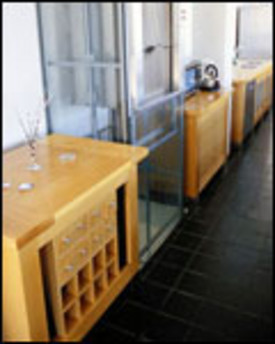 Wood counters add natural warmth and beauty to kitchen space. Select a grain profile and finish that highlight the wood and complement the way you live and cook. |
Wood Segments Make Up Block
A wood countertop or butcher block top is not one solid block of wood but wood segments that are glued together and planed smooth. How the wood segments are arranged and which grain of the wood is visible helps determine the top’s look and strength. The grain types are referred to as:
- Face grain, which uses the surface width of the board.
- Edge grain, which uses strips placed on edge.
- End grain, which uses blocks of wood arranged so that their ends point up revealing the growth rings.
Tight-grained, hard maple has long been a traditional favorite for countertop wood. Rich-grained red oak has also become popular. Butcher block fabricators like DeVos Custom Woodworking in Dripping Springs, Texas, use several woods for their countertops including Brazilian cherry and mesquite, which are even harder than maple and have beautiful color and tone. African mahogany, with colors ranging from deep maroon to light tan, and zebra wood–the color of hard maple with black and brown stripes—are not only unusual but certified by the Forest Stewardship Council as sustainable woods for commercial harvesting.
Stock and Custom Wood Countertops
Stock countertop blanks are typically 1½ inches thick and 25 inches deep, and come in lengths that increase by one-foot increments to 12 feet long. Custom fabricators, like Block Tops in Anaheim, Calif., can create countertops as shallow as 1¾-inch thick in lengths and widths that are only limited by access, according to Vice President Nate Kolenski. Fabricators create a variety of edges and backsplashes and can provide such options as removable stainless-steel grids to serve as built-in hot plates.
Wood Countertop Finishes
Wood oxidizes over time and some woods, like cherry and teak, change their color a bit more than others as they age. Wood also gains and loses moisture, depending on its environment. To save wood from drying out and to enhance its natural beauty, a finish is required. The right finish can depends on countertop use, personal preference, and options offered by the product manufacturer.
Countertop manufacturers often offer a special blended finish that they find gives greater beauty, a nicer look, and a higher level of protection than a natural oil finish. Most, however, offer customers the option of selecting the finish they desire. A good countertop finish should retain the moisture of the wood and keep food residue and surface moisture out.
Maintenance and Repair
Wood countertop fabricators say there is still a misconception that wood is not a sanitary surface. The unsanitary factor, they say, comes from using vegetable oils or animal fats—instead of mineral oil—to treat the wood surface. Organic fats run the risk of going rancid and becoming a health hazard by promoting bacteria growth.
 |
||||
|
||||
Wood countertops are considered easy to repair. When they need refreshing, most only require a bit of sanding with a 220 fine-grit sandpaper and re-oiling. Some only need a reapplication of the special finish with which they were surfaced.
Most countertops should be cleaned with soap and water. Bleach additives and abrasives can damage finishes and penetrate the wood. Spills should not be a problem if the finish is in good shape they are cleaned up within a few minutes.
Installation and Special Cutouts
Because wood expands and contracts on its width, not its length, it’s important that the installer follow the manufacturer’s instructions. Some manufacturers prefer that their tops be attached using slotted screw holes instead of gluing the countertop to the cabinet with adhesive caulk. This method does not cause the top to be less secure but does allow it to move.
While any kind of sink can work in a wood countertop, most installers prefer self-rimming, drop-in sinks. Undermount and country farm sinks are more liable to open the countertop to damage from daily dings or moisture migration. All countertop cutouts must be protected with a waterproof finish and maintained in good condition. For cooktop cutouts, you may need to dissipate the heat through insulation.
Pricing Wood Countertops
A custom-built maple top with a standard edge can range from $45 to $75 per square foot. On average, walnut costs about $98 per square foot and teak or zebra wood costs $132. Installation can add as much as 20 percent.
A standard wood countertop blank is typically $30 to $40 per square foot installed. Home centers and building supply stores sell maple countertop blanks for about $20 per square foot.
Fancy edge treatments typically add about $6 per lineal foot, while custom stain mixes can add an additional $13 per square foot.
Credit: Renovate Your World




























